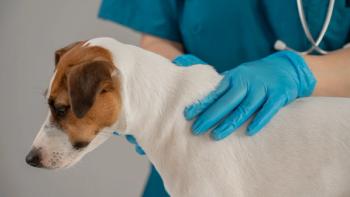
An earful of advice for managing chronic otitis cases
Veterinary dermatologist Lynette Cole spent months working with a Cavalier King Charles spaniel named Hank suffering from bilateral otitis externa. Here are some of the takeaways from the case you might want to dog-ear for your future reference.
(Shutterstock.com)At a recent
As is the nature of the tricky inflammatory beast, a successful outcome relied on some deft detective work, a little trial and error and a lot of patience. As Dr. Cole puts it: “Knowing that our patients have otitis externa isn't the hard part. The hard part is knowing how to diagnose, treat and manage it.”
Here are some takeaways from Hank's case that could help you with the hard part of chronic otitis cases in your practice.
Get the whole history
A thorough history can be crucial in chronic otitis cases, which is why Hank's owner filled out an extensive history sheet before visiting Dr. Cole. In addition to the obvious questions (e.g. How long has the dog had otitis? What treatments have been tried? What is the dog being treated with now? What were the results of previous cultures and cytologies?), knowing what kind of household the pet lives in, whether it's around other pets, what it eats (including treats), and what kind of flea, tick and heartworm preventives it's given can help guide your treatment plan later on.
Don't rule out allergy just yet
Dr. Cole told attendees that 50% of chronic recurrent otitis externa cases are allergy related. When Hank presented to Dr. Cole, only his ears were pruritic, but that doesn't rule out allergy.
“Here's a key point: In 10% to 25% of dogs with atopic dermatitis or cutaneous adverse food reaction, otitis can be the first and only sign of these diseases and they don't have to be pruritic anywhere else,” she said.
Probe the three Ps
Hank's general exam was normal, and his dermatologic exam confirmed that only his ears were affected. His otic exam showed ulcerations, firm but malleable ear canals, erythema and dark-brown, mucoid exudate that obscured her view of the tympanic membrane.
“At this point,” said Dr. Cole, “it was time for the differentials, or the three Ps: primary causes, predisposing and perpetuating factors.”
Dr. Cole interviewed Hank's owner in an attempt to discover some predisposing factors. After learning that her client was not using Q-tips to clean his ears, or plucking, or getting his ears wet (whether by swimming or during baths), Dr. Cole determined that her patient's only predisposing factor was his pendulous pinnae.
With no clinical signs of endocrine disease or parasites, and considering how unlikely it would be for Hank to have a tumor or polyps, Dr. Cole's primary cause in this case was allergy until proven otherwise.
As for the perpetuating factors, “we assume the external ear canal is infected,” she said. “But the middle ear could also be infected. He could have mucus in his middle ear due to primary secretory otitis media. And he has progressive pathologic changes noted from the otic exam (e.g. firm but malleable ear canals, hyperplasia, stenosis). We have a number of things we need to manage.”
Taking the time to go through these three Ps will help you with another P: your plan.
Categorize your cytologies
Because infection was suspected, Dr. Cole's first order of business after going through the three Ps was to perform a cytology. She offered some advice on how to make the findings more useful.
“It's important to categorize what you see, so I use a labeling system,” she said.
Here's the rundown:
1+ = four to 10 organisms per oil immersion field (OIF)
2+ = 10 to 20 organisms/OIF
3+ = 20 to 30 organisms/OIF
4+ = greater than 40 organisms/OIF
4++ = every single field (Dr. Cole looks at 10 fields) is full of organisms
Do your future self a favor and follow her lead.
“If I just write ‘rods and cocci,' then I won't really know if things are getting better when I repeat the cytology when the dog comes back for a recheck examination,” Dr. Cole explained.
Don't use the force
Dr. Cole doesn't worry about getting the full picture during the first otic exam. “You don't always have to get the scope all the way into the ear to get the point,” she advised. “Sometimes I can't even get into the ear canal at all because it's so hyperplastic [as was the case with Hank]. You just need to get an idea of the degree of the progressive pathologic changes to be able to compare what you find at the recheck examination.”
Look beyond the food bowl
With food allergy as the potential primary cause, a diet trial was an important part of getting to a diagnosis for Hank. Remember that thorough history? Dr. Cole revisited it because Hank's diet wasn't his only source of protein. His flea and heartworm medications contained flavoring, so Dr. Cole switched Hank to a flavorless heartworm preventive and a topical flea preventive.
Dr. Cole had also learned from the history that Hank's owner brushed his teeth with a poultry-flavored toothpaste, so that was changed to a vanilla mint paste.
“We've got to look at and eliminate those other protein sources,” she explained, so be sure to explore everything the dog ingests.
Don't scare your food trial clients
The best-laid plans of mice and men often go awry. In other words, your diet trial may encounter some glitches. In Hank's case, the owner thought he may have gotten ahold of a treat he wasn't supposed to have (according to his history, Hank belonged to a breeder and shared a home with several other dogs).
Though it can be frustrating, Dr. Cole said it's in your best interest (and thus the patient's best interest) to avoid badgering your clients too much. Encourage them to be honest. You want them to feel like you trust them but that you'll be understanding if a mistake is made.
“If the dog's been accidentally getting into something, or if the owner's been giving the pills with cheese, I need to know that,” said Dr Cole. Don't create a situation in which your client is too ashamed and afraid of your reaction to tell the truth.
Be in it for the long haul
In closing, Dr. Cole reminded the audience that finding the primary cause takes time (a fact you may want to tell your clients upfront as well). In Hank's case, it took months to definitively diagnose him with cutaneous adverse food reaction.
Dr. Cole also advised against stopping treatment too soon.
“Treat until there's not only no organisms (that's a no-brainer), but also no inflammatory cells or nuclear streaming cytologically. If those are present, it's telling you that there's still inflammation and infection in the ear,” she explained. “And the last thing you want to do is stop too soon and have everything relapse.”
Newsletter
From exam room tips to practice management insights, get trusted veterinary news delivered straight to your inbox—subscribe to dvm360.






